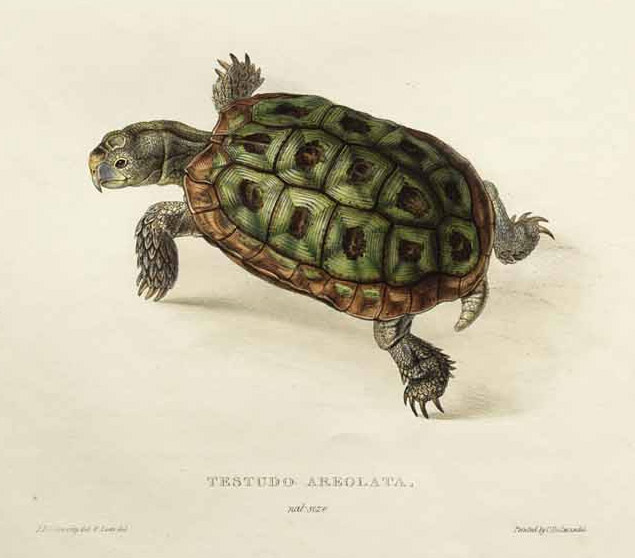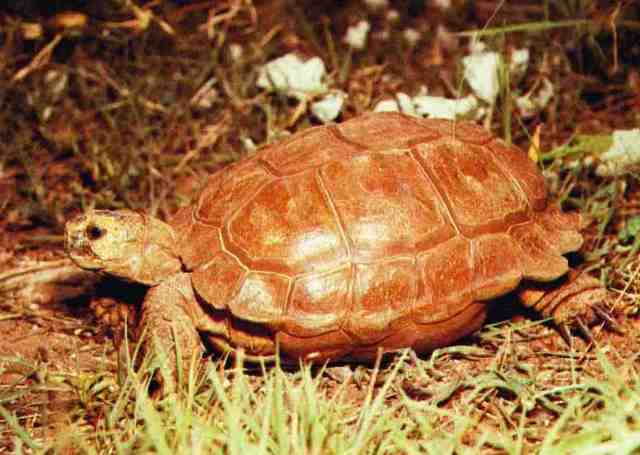|
Homopus
''Homopus'' is a genus of tiny tortoises in the family Testudinidae, endemic to southern Africa. Three species formerly included in ''Homopus'' were reclassified into the genus ''Chersobius'', leaving two remaining as ''Homopus'': the common padloper ('' H. areolatus'') and the greater padloper ('' H. femoralis''). Naming As a group, the closely related species in ''Homopus'' and ''Chersobius'' are commonly known in Europe and Africa as padlopers (originally meaning "path-walkers" in Afrikaans), due to their habit of making tiny pathways through vegetation. In other parts of the world, such as the United States, they are known as Cape tortoises. Distribution The genus is indigenous and endemic to South Africa. Species The genus contains these species: Conservation and captivity They are threatened by habitat destruction, traffic on roads, overgrazing, and poaching for the pet trade. Another threat comes from introduced species An introduced species, alien speci ... [...More Info...] [...Related Items...] OR: [Wikipedia] [Google] [Baidu] |
Homopus Areolatus
''Homopus areolatus'', commonly known as the common padloper or parrot-beaked tortoise, is a tiny species of tortoise of the genus ''Homopus'', indigenous to the southern part of South Africa. Naming ''Homopus areolatus'' is known by a wide range of common names. In its native region in southern Africa (and in much of the scientific community) it is usually known as the common padloper due to its being by far the most commonly occurring of all the ''Homopus'' ("padloper") species.Loehr, V., "", World Chelonian Trust (retrieved August 20, 2013) It is also commonly known as the parrot-beaked tortoise, due to the relatively large beak that the males of the species possess. species gallery. [...More Info...] [...Related Items...] OR: [Wikipedia] [Google] [Baidu] |
Homopus Femoralis
''Homopus femoralis'', commonly known as the greater padloper, is a small tortoise of the genus ''Homopus'', indigenous to the highveld grasslands of South Africa.Karoo Cape tortoise CITES species gallery. Description  As its name suggests, the greater padloper is the largest of all the ''Homopus'' ("padloper") tortoises, but it is nonetheless tiny, averaging slightly over 10 cm in length – though males tend to be smaller. It has relatively large buttock tubercles. Like its close relative, ''common padloper, H. areolatus'' (and unlike other Homopus, padlopers), it has only four toe ...
As its name suggests, the greater padloper is the largest of all the ''Homopus'' ("padloper") tortoises, but it is nonetheless tiny, averaging slightly over 10 cm in length – though males tend to be smaller. It has relatively large buttock tubercles. Like its close relative, ''common padloper, H. areolatus'' (and unlike other Homopus, padlopers), it has only four toe ...
[...More Info...] [...Related Items...] OR: [Wikipedia] [Google] [Baidu] |
Homopus
''Homopus'' is a genus of tiny tortoises in the family Testudinidae, endemic to southern Africa. Three species formerly included in ''Homopus'' were reclassified into the genus ''Chersobius'', leaving two remaining as ''Homopus'': the common padloper ('' H. areolatus'') and the greater padloper ('' H. femoralis''). Naming As a group, the closely related species in ''Homopus'' and ''Chersobius'' are commonly known in Europe and Africa as padlopers (originally meaning "path-walkers" in Afrikaans), due to their habit of making tiny pathways through vegetation. In other parts of the world, such as the United States, they are known as Cape tortoises. Distribution The genus is indigenous and endemic to South Africa. Species The genus contains these species: Conservation and captivity They are threatened by habitat destruction, traffic on roads, overgrazing, and poaching for the pet trade. Another threat comes from introduced species An introduced species, alien speci ... [...More Info...] [...Related Items...] OR: [Wikipedia] [Google] [Baidu] |
Tortoise
Tortoises ( ) are reptiles of the family Testudinidae of the order Testudines (Latin for "tortoise"). Like other turtles, tortoises have a shell to protect from predation and other threats. The shell in tortoises is generally hard, and like other members of the suborder Cryptodira, they retract their necks and heads directly backward into the shell to protect them. Tortoises can vary in size with some species, such as the Galápagos giant tortoise, growing to more than in length, whereas others like the Speckled cape tortoise have shells that measure only long. Several lineages of tortoises have independently evolved very large body sizes in excess of , including the Galapagos giant tortoise and the Aldabra giant tortoise. They are usually diurnal animals with tendencies to be crepuscular depending on the ambient temperatures. They are generally reclusive animals. Tortoises are the longest-living land animals in the world, although the longest-living species of tortois ... [...More Info...] [...Related Items...] OR: [Wikipedia] [Google] [Baidu] |
Testudinidae
Tortoises ( ) are reptiles of the family Testudinidae of the order Testudines (Latin for "tortoise"). Like other turtles, tortoises have a shell to protect from predation and other threats. The shell in tortoises is generally hard, and like other members of the suborder Cryptodira, they retract their necks and heads directly backward into the shell to protect them. Tortoises can vary in size with some species, such as the Galápagos giant tortoise, growing to more than in length, whereas others like the Speckled cape tortoise have shells that measure only long. Several lineages of tortoises have independently evolved very large body sizes in excess of , including the Galapagos giant tortoise and the Aldabra giant tortoise. They are usually diurnal animals with tendencies to be crepuscular depending on the ambient temperatures. They are generally reclusive animals. Tortoises are the longest-living land animals in the world, although the longest-living species of tortoise ... [...More Info...] [...Related Items...] OR: [Wikipedia] [Google] [Baidu] |
Chersobius
''Chersobius'' is a genus of tiny tortoises in the family Testudinidae, endemic to southern Africa. The genus includes the smallest tortoises in the world. All three species were previously assigned to the genus ''Homopus''. Naming As a group, these closely related species are commonly known in Europe and Africa as padlopers (originally meaning "path-walkers" in Afrikaans), due to their habit of making tiny pathways through vegetation. In other parts of the world, such as the United States, they are known as Cape tortoises. Distribution The genus is indigenous and endemic to southern Africa, one within South Africa, Berger's Cape Tortoise, one only in Namibia, and Speckled tortoise, one possibly spanning across the border region of both countries. Species The genus contains these species: Conservation and captivity They are threatened by habitat destruction, traffic on roads, overgrazing, and poaching for the pet trade. Among the ''Chersobius'' species, ''C. signatus'' adap ... [...More Info...] [...Related Items...] OR: [Wikipedia] [Google] [Baidu] |
Habitat Destruction
Habitat destruction (also termed habitat loss or habitat reduction) occurs when a natural habitat is no longer able to support its native species. The organisms once living there have either moved elsewhere, or are dead, leading to a decrease in biodiversity and species numbers. Habitat destruction is in fact the leading cause of biodiversity loss and species extinction worldwide. Humans contribute to habitat destruction through the use of natural resources, agriculture, industrial production and urbanization (urban sprawl). Other activities include mining, logging and trawling. Environmental factors can contribute to habitat destruction more indirectly. Geological processes, climate change, introduction of invasive species, ecosystem nutrient depletion, water and noise pollution are some examples. Loss of habitat can be preceded by an initial habitat fragmentation. Fragmentation and loss of habitat have become one of the most important topics of research in ecology as the ... [...More Info...] [...Related Items...] OR: [Wikipedia] [Google] [Baidu] |
Taxa Named By André Marie Constant Duméril
In biology, a taxon (back-formation from ''taxonomy''; : taxa) is a group of one or more populations of an organism or organisms seen by taxonomists to form a unit. Although neither is required, a taxon is usually known by a particular name and given a particular ranking, especially if and when it is accepted or becomes established. It is very common, however, for taxonomists to remain at odds over what belongs to a taxon and the criteria used for inclusion, especially in the context of rank-based (" Linnaean") nomenclature (much less so under phylogenetic nomenclature). If a taxon is given a formal scientific name, its use is then governed by one of the nomenclature codes specifying which scientific name is correct for a particular grouping. Initial attempts at classifying and ordering organisms (plants and animals) were presumably set forth in prehistoric times by hunter-gatherers, as suggested by the fairly sophisticated folk taxonomies. Much later, Aristotle, and later still ... [...More Info...] [...Related Items...] OR: [Wikipedia] [Google] [Baidu] |
Turtle Genera
Turtles are reptiles of the order (biology), order Testudines, characterized by a special turtle shell, shell developed mainly from their ribs. Modern turtles are divided into two major groups, the Pleurodira (side necked turtles) and Cryptodira (hidden necked turtles), which differ in the way the head retracts. There are 360 living and recently extinct species of turtles, including land-dwelling tortoises and freshwater terrapins. They are found on most continents, some islands and, in the case of sea turtles, much of the ocean. Like other Amniote, amniotes (reptiles, birds, and mammals) they breathe air and do not lay eggs underwater, although many species live in or around water. Turtle shells are made mostly of bone; the upper part is the domed Turtle shell#Carapace, carapace, while the underside is the flatter plastron or belly-plate. Its outer surface is covered in scale (anatomy), scales made of keratin, the material of hair, horns, and claws. The carapace bones deve ... [...More Info...] [...Related Items...] OR: [Wikipedia] [Google] [Baidu] |
Reptiles Of South Africa
The wildlife of South Africa consists of the flora and fauna of this country in Southern Africa. The country has a range of different habitat types and an ecologically rich and diverse wildlife, vascular plants being particularly abundant, many of them Endemism, endemic to the country. There are few forested areas, much savanna grassland, semi-arid Karoo vegetation and the fynbos of the Cape Floristic Region. Famed for its national parks and big game, 297 species of mammal have been recorded in South Africa, as well as 849 species of bird and over 20,000 species of vascular plants. Geography South Africa is located in subtropical southern Africa, lying between 22nd parallel south, 22°S and 35th parallel south, 35°S. It is bordered by Namibia, Botswana and Zimbabwe to the north, by Mozambique and Eswatini (Swaziland) to the northeast, by the Indian Ocean to the east and south, and the Atlantic Ocean to the west, the coastline extending for more than . The interior of the countr ... [...More Info...] [...Related Items...] OR: [Wikipedia] [Google] [Baidu] |
Turtles Of Africa
African reptiles are categorized by reptilian order: Order Testudines: turtles Order Squamata: snakes and lizards *Acanthocercus *Acanthodactylus erythrurus *Acanthodactylus mechriguensis *Agama (genus) *Agama agama *Agama aculeata *Agama africana *Agama armata *Agama caudospinosa *Agama mwanzae *Agama rueppelli *Aspidelaps *Atheris ceratophora *Atheris chlorechis *Atheris desaixi *Atheris hispida *Atheris katangensis *Atheris nitschei *Atheris squamigera *Bitis arietans *Bitis atropos *Bitis caudalis *Bitis cornuta *Bitis gabonica *Bitis heraldica *Bitis inornata *Bitis nasicornis *Bitis parviocula *Bitis peringueyi *Bitis rubida *Bitis schneideri *Bitis worthingtoni *Bitis xeropaga *Boomslang *Boulengerina annulata *Cape Cobra *Cape Dwarf Chameleon *Chalcides armitagei *Chalcides montanus *Chalcides ocellatus *Chalcides pulchellus *Chalcides regazzii *Chalcides thierryi *Chamaeleo hoehnelii *Chamaeleo johnstoni *Chamaeleo melleri *Charina *Common Egg-eater *Eastern green mamb ... [...More Info...] [...Related Items...] OR: [Wikipedia] [Google] [Baidu] |







